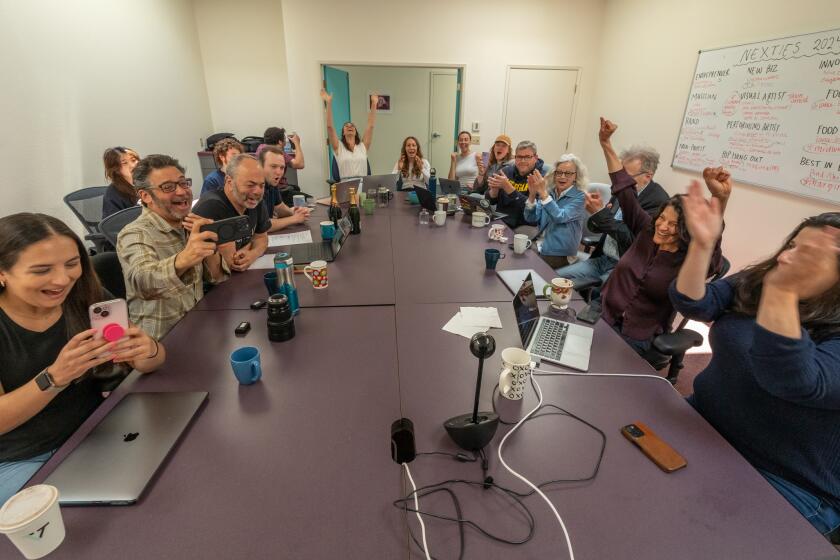Consensus Reached on Development Plan for Fragile Ormond Beach
Conservationists consider Ormond Beach the environmental jewel of Oxnard with its fragile wetlands that are home to several protected species.
Developers, however, see these 1,400 acres in south Oxnard as an economic gem where they could build thousands of homes and a shopping center.
Capping six months of work to reach a compromise, a special task force of industrial leaders, resource agencies, government officials and environmentalists Wednesday approved a far-reaching blueprint for the area’s future.
The Ormond Beach Task Force’s consensus plan essentially divides the coastal property, which lies mainly south of Pleasant Valley Road, into six types of zones, including development-free conservation areas, areas for industrial activity and 500 acres for homes.
But absent from the meeting was the Baldwin Co., the financially struggling developer that owns about 400 acres in the area and wants to build up to 5,000 homes there.
*
Nick Gorely, a Baldwin Co. senior vice president, said in an interview Wednesday that he believes the task force has moved too fast in reaching its consensus plan.
Gorely said the Baldwin Co. has not yet supported the plan because the company still wants to trade some of its land in Ormond Beach with nearby landowner Southern California Edison Co., which has declined the offer.
Gorely also said Baldwin is awaiting a report from the U.S. Army Corps of Engineers on the actual boundaries of the wetlands, which cover as much as 200 acres of the 1,400-acre study area.
“We communicated that those issues needed to be resolved first,” Gorely said. “Apparently, the task force decided to move forward. They are free to do that.”
Members of the Ormond Beach Task Force said those issues may never be resolved to the satisfaction of the Baldwin Co., adding that they regret that the Orange County-based developer stopped attending the meetings in October--about three months after filing for Chapter 11 bankruptcy protection.
*
But task force members said their plan has wide consensus from those in the area, including Willamette Industries, which operates a cardboard recycling plant; the Greater Oxnard Economic Development Corp.; and regulatory agencies such as the California Coastal Commission and the state Department of Fish and Game.
It is ultimately up to the city of Oxnard to decide the future of Ormond Beach, including any developments in the area. Despite the lack of approval from the Baldwin Co., task force members touted the plan as one that takes into account the site’s economic potential and the need to conserve its abundant natural resources.
“We are very sad that the developer was not able to participate in all of the proceedings. But you are not necessarily going to get everybody to agree. It is the city’s call,” said task force member Roma Armbrust, chairwoman of the conservation group Ormond Beach Observers.
Armbrust said the task force working group that designed the plan will meet again March 27 to fine-tune the document. The group then will take the plan to the City Council for review. They say they will also ask city leaders to consider their plan as an alternative to Baldwin’s proposed subdivisions when studying the environmental impacts of proposed development at Ormond Beach.
*
Deanna Walsh, Oxnard’s coastal planner, said the city-selected environmental consultant has halted work on analyzing the environmental impact of the Baldwin proposal because the company had stopped making its scheduled payments.
The Baldwin Co. has sought for years to build houses at Ormond Beach--and on a nearby inland parcel called Village West--but the process has been slowed by citizen concerns, environmental reviews and most recently, its bankruptcy filing.
Under the task force proposal, beachfront areas would remain undeveloped. The beach and neighboring areas serve as a habitat for several protected species including the tidewater goby fish, California least tern and the California brown pelican.
Task force members have included plans for a nature center and a series of pavilions allowing the public to view the wetlands and animal life.
The plan also calls for a “conservation credit” arrangement that would give owners of a large plot in the middle of the 1,400 acres a financial incentive to not develop the land and restore native plant life.
*
And the vacant land immediately north of the Southern California Edison plant at the end of South Edison Drive would serve as a buffer zone--possibly in the form on a golf course--from housing developments north of McWane Boulevard.
The plan “makes a good attempt at balancing the conservation need while still allowing economic development to take place,” said Morgan Wehtje, a wildlife biologist for the state Department of Fish and Game who helped draft the plan. “It was a plan that was based on the biology of Ormond Beach.”
But Wehtje said any development--even one such as this that locates homes farther from the wetlands than the original Baldwin proposal--would put wildlife at risk.
“You are going to pump more people in the area,” Wehtje said. “You are going to have to manage the resources very carefully.”
More to Read
Start your day right
Sign up for Essential California for news, features and recommendations from the L.A. Times and beyond in your inbox six days a week.
You may occasionally receive promotional content from the Los Angeles Times.






